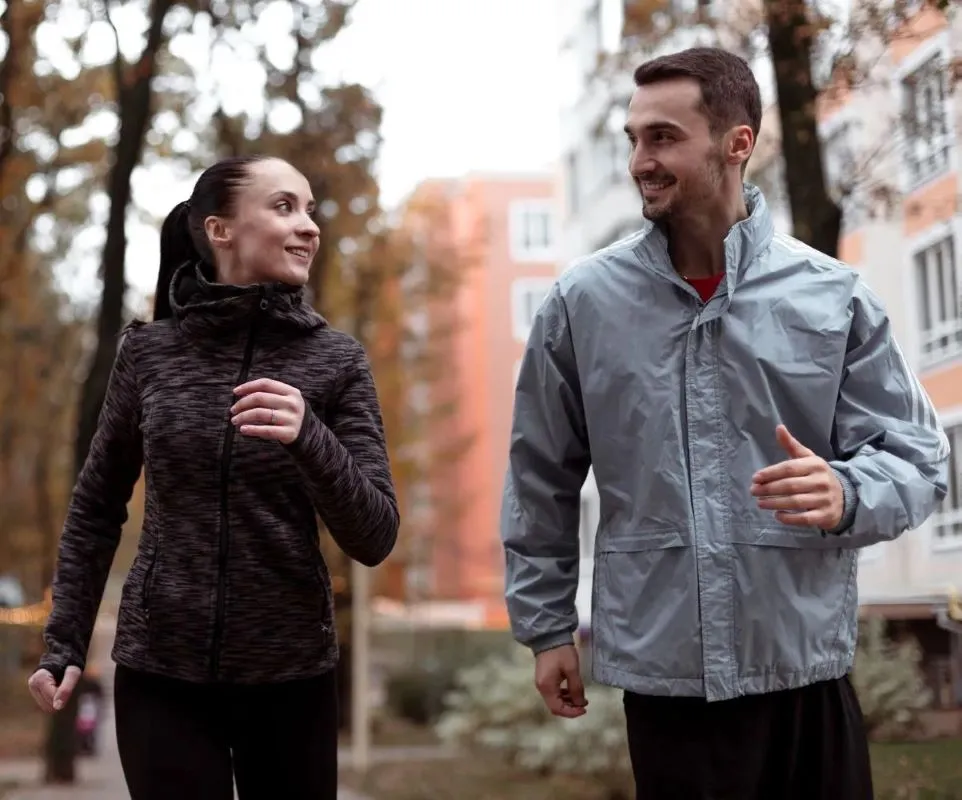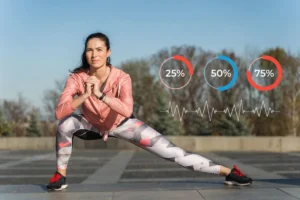Introduction
In our busy world with lots of things to do and distractions, it’s hard to find calm and feel refreshed. But even with all the noise, there’s a simple thing that can make us feel better: walking. It’s good for our body and mind. Walking makes your heart and lungs stronger. It lowers the chance of heart problems and strokes. It helps with issues like high blood pressure, high cholesterol, and joint pain. Walking also makes your bones stronger and helps you keep your balance.
Rediscovering the Joy of Walking
Imagine walking outside, hearing the leaves crunch beneath your feet, feeling your breath match your steps, and being surrounded by nature. Walking isn’t just about getting from one place to another. It’s been around for a long time and is important for our health.
In this modern age of technology and convenience, the art of walking has somewhat been overshadowed by the allure of faster modes of transportation and sedentary lifestyles. However, as research continues to unveil the myriad of benefits associated with this seemingly simple activity, the humble act of walking is experiencing a renaissance.
Physical Health Benefits of Walking
The physical benefits of walking extend far beyond merely getting from point A to point B. Regular walking, even at a moderate pace, has been shown to reduce the risk of chronic diseases and improve overall physical fitness.
- Heart Health: One of the most significant advantages of walking is its positive impact on cardiovascular health. Studies have consistently demonstrated that brisk walking can lower blood pressure, improve cholesterol levels, and reduce the risk of heart disease and stroke.
- Weight Management: For those striving to maintain a healthy weight, walking can be a powerful ally. Not only does it burn calories, but it also boosts metabolism and helps preserve lean muscle mass, making it an effective strategy for weight management and obesity prevention.
- Joint Health: Contrary to popular belief, walking is gentle on the joints and can help alleviate joint pain and stiffness. The low-impact nature of walking makes it an ideal form of exercise for individuals with arthritis or joint issues, providing both mobility and pain relief.
- Bone Strength: Walking is a weight-bearing exercise, which means it helps strengthen bones and reduce the risk of osteoporosis. By stimulating bone formation and density, regular walking can contribute to better bone health and reduce the likelihood of fractures as we age.
Mental Health Benefits of Walking
Beyond its physical perks, walking also exerts a profound influence on mental well-being, offering a natural remedy for stress, anxiety, and depression.
- Stress Reduction: In today’s hectic world, stress has become a ubiquitous presence in our lives. Fortunately, walking provides a simple yet effective way to combat stress by triggering the release of endorphins, the body’s natural mood lifters. A stroll through nature can work wonders in calming the mind and restoring inner peace.
- Mood Enhancement: The link between exercise and mood regulation is well-established, with walking emerging as a particularly potent mood enhancer. Research suggests that regular walking can alleviate symptoms of depression and anxiety, promoting feelings of happiness and well-being.
- Cognitive Function: As we age, cognitive decline becomes a growing concern for many. However, walking has been shown to offer protection against cognitive impairment and neurodegenerative diseases such as Alzheimer’s. By improving blood flow to the brain and fostering neuroplasticity, walking nurtures cognitive function and enhances mental clarity.
- Creativity Boost: Ever noticed how your most creative ideas often come to you during a stroll? Walking has been found to stimulate creative thinking and problem-solving abilities, making it an invaluable tool for enhancing innovation and productivity.
The Science Behind Walking: Research Insights
The remarkable benefits of walking are not merely anecdotal; they are supported by a wealth of scientific evidence from various fields of research.
- Cardiorespiratory Fitness: A study published in the American Journal of Preventive Medicine found that regular walking significantly improved cardiorespiratory fitness, leading to a reduced risk of mortality from cardiovascular disease.
- Mental Health: Research conducted at the University of Essex revealed that just a five-minute walk in nature could elevate mood and self-esteem, while a study in the British Journal of Sports Medicine reported that walking outdoors was associated with lower levels of depression and higher levels of well-being.
- Longevity: A large-scale study published in the journal Circulation concluded that brisk walking was associated with a longer life expectancy, with each additional 30 minutes of daily walking reducing mortality risk by 20%.
- Brain Health: Neuroscientists at the University of Illinois found that regular aerobic exercise, such as walking, led to improvements in brain structure and function, including enhanced connectivity in areas responsible for memory and cognition.
Incorporating Walking Into Your Daily Routine
Embracing a daily walking habit doesn’t require elaborate plans or special equipment; all it takes is a pair of comfortable shoes and a willingness to step outside and explore. Here are some practical tips for incorporating walking into your daily routine:
- Start Slow: If you’re new to walking or exercise in general, start with short, manageable walks and gradually increase the duration and intensity over time. Aim for at least 30 minutes of brisk walking most days of the week.
- Find Your Route: Whether it’s a scenic trail in the countryside or a bustling city street, choose walking routes that inspire and motivate you. Exploring different environments can add variety to your walks and keep things interesting.
- Make It Social: Invite friends, family members, or furry companions to join you on your walks. Not only does walking with others foster social connections, but it also provides accountability and encouragement to stay active.
- Stay Consistent: Consistency is key when it comes to reaping the full benefits of walking. Make it a priority to incorporate walking into your daily routine, scheduling it at a time that works best for you, whether it’s first thing in the morning, during your lunch break, or in the evening after dinner.

Advanced Manner and Mental Clarity
When you walk in a steady rhythm, your body releases chemicals called endorphins, which make you feel good. This natural boost can improve your mood and clear your mind, giving you a positive outlook on life.
Combating Uneasiness and Feeling sorry for
Walking has been found to help with anxiety and depression. When you walk outside, the combination of moving your body and being in nature can help your mental health.
Social Affiliations Through Strolling
Gather Strolls and Community Engagement
Walking gives you a chance to make friends. When you join group walks or community events, it not only makes walking more fun but also helps you feel like you belong.
Openings for Holding
Walking with friends or family is a great way to spend time together. It’s a fun way to chat with loved ones while also getting the physical and mental benefits of walking together.
Strolling and Imaginative Considering
Reinforcing Innovativeness
Simply walking has been linked to more creativity. Whether you’re strolling in a park or around your neighborhood, seeing new things and moving your body can help boost your creative thinking.
Overhauling Problem-Solving Capacities
Studies suggest that walking can make problem-solving skills better. Listening to music while walking in nature seems to stimulate the brain, making it work better.
Cementing Strolling into a Day-by–Day Plan
Making it an Affinity
To get all the good things from walking, it’s important to make it a habit. Start with short walks and gradually make them longer as you get stronger.
Choosing Walking-Friendly Courses
Selecting charming courses or joining strolling trails into your arrangement can make the involvement more satisfying. This may be a bewildering way to examine your neighborhood community.
Strolling Strategies for the Most Unmistakable Impact
Speed and Term Recommendation
Although any diagram of strolling is useful, brisk strolling for at least 30 minutes a day is prescribed for the most exceptional success. Alter the term based on your wellness level.
Joining together Interior and Collections
To keep things curious and boost the ampleness of your strolls, consider setting the interior of speedier strolling or tallying collections like slants.
Strolling vs. Truly Workouts
Attainable Wellness
Not at all like genuine workouts, which can lead to burnout, strolling offers a viable wellness course of activity. It can be kept up over the long term, contributing to common success and well-being.
Diminished Threat of Wounds
High-intensity workouts routinely come with a chance of wounds. Strolling, being low-impact, minimizes the chances of strains or wounds, making it sensible for individuals of all wellness levels.
Walking and Rest Quality
Setting up a Rest Arrange
Standard strolling has been related to improvements in rest quality. Building up a plan, such as an evening walk, signals to the body that it’s time to wind down, advancing predominant rest.
Connection Between Strolling and Overwhelming Rest
It appears that people who bolt into conventional physical advancements, such as strolling, incorporate way better rest plans. It contributes to a more loosening-up night’s rest and an expansive rest quality.
Modifying Strolling for Contrasting Ways of Life
Energetic Plans and Time Organization
Joining an energetic organization is achievable with productive time management. Brief strolls in the middle of breaks or joining together for strolling social events can be an imperative capability.
Joining Strolling into Work Breaks
For those with inactive occupations, taking brief walking breaks can combat the negative impacts of deferred sitting. It’s a practical way to remain enthusiastic all through the day.
Characteristic Benefits of Walking
Diminished Carbon Impression
Choosing strolling over motorized transportation contributes to a decrease in carbon emissions. It’s an eco-friendly choice that alters a reasonable and ecologically cognizant way of life.
Pushing for Eco-Friendly Transportation
Advancing strolling as a mode of transportation not only benefits a person’s prosperity but also underpins common conservation. It’s a little, in any case, an impactful step towards reducing dependence on fossil fuels.
Strolling Challenges and Occasions
Setting Individual Challenges
Challenging yourself to achieve strolling turning centers is a fun and persuading component of your plan. Whether it’s coming to a certain number of steps each day or taking part in strolling challenges, setting goals keeps the development locked in.
Sharing in Organized Strolling Occasions
Different communities organize strolling occasions or marathons. On these occasions, taking a parcel is not because it gives a sense of achievement but rather because it licenses you to relate with like-minded people who share an essentialness for strolling.
How many calories can you burn by walking 10 miles each day?
Walking 10 miles a day can lead to significant weight loss, but the exact amount depends on various factors like your weight, walking speed, and overall diet. On average, walking 10 miles burns about 800-1,000 calories, depending on your pace and body weight.
To put it into perspective:
- For a 150-pound person: Walking 10 miles might burn around 900 calories.
- For a 200-pound person: It could burn around 1,200 calories.
Since losing 1 pound of body weight generally requires a calorie deficit of about 3,500 calories, walking 10 miles daily could help you lose approximately 1-2 pounds a week, assuming your diet remains the same. However, it’s crucial to balance exercise with a healthy diet and avoid overcompensating with extra food.
Developing Agilely with a Strolling Plan
As we age, remaining enthusiastic becomes pivotal for keeping up with the foremost portion of well-being. Strolling, with its delicate nature, gets to be a marvelous choice for older people, advancing flexibility and opportunity inside the creating handle.
Changing Strolling with Other Works out
Coordination Quality Arranging and Flexibility Workout
Even though strolling gives different benefits, combining it with other types of workouts makes a well-rounded wellness arrangement. Joining quality arrangements and flexibility works out guarantees all counting success.
Making a Comprehensive Wellness Orchestrate
Orchestrating a comprehensive wellness organization that consolidates walking and following other works is key to wrapping up wellness targets. It addresses unmistakable points of view of physical success, from cardiovascular wellness to muscle quality and adaptability.

Conclusion
In conclusion, the benefits of walking amplify the distance of a past, clear physical workout. Getting a handle on a standard strolling arrangement positively impacts both physical and mental success, creating an all-encompassing sense of well-being. The effortlessness and openness of strolling make it a versatile and sensible development for people of all ages and wellness levels.
FAQs
1) How long do I walk each day to get the benefits?
Point for at least 30 minutes of brisk strolling most days of the week to maximize prosperity benefits.
What is the difference between cycling and running in terms of weight loss?
Both cycling and running are effective for weight loss, but they differ in intensity, muscle engagement, and impact on the body:
- Calories Burned: Running generally burns more calories per minute than cycling because it requires more energy to support your body weight while moving. However, cycling can still be a significant calorie-burner, especially if done at a high intensity or over longer distances.
- Muscle Engagement: Running primarily works the lower body muscles, particularly the legs, and glutes, but also engages the core. Cycling also targets the legs and glutes but tends to focus more on the quadriceps and calves. Cycling can also be less stressful on the joints, making it a better option for those with joint issues.
- Impact: Running is a high-impact exercise, which can be tough on the joints, particularly the knees. Cycling, on the other hand, is low-impact and easier on the joints, making it suitable for people recovering from injuries or with joint concerns.
- Sustainability: Because cycling is low-impact, it may be easier to sustain for longer periods, allowing for more extended workouts, which can contribute to more significant calorie burn over time.
In summary, both activities are effective for weight loss, but running burns more calories in less time, while cycling is gentler on the body and can be sustained longer. The choice between them can depend on personal preferences, physical condition, and specific fitness goals.



